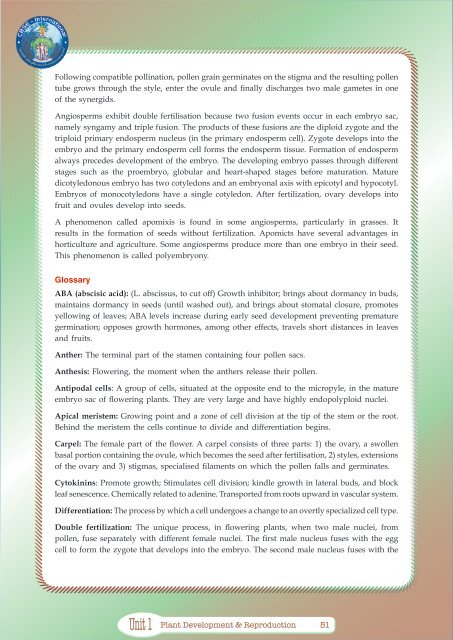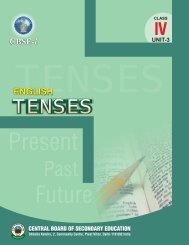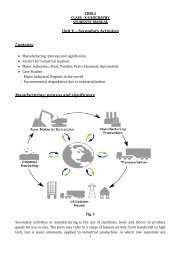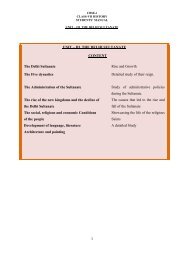PLANT DEVELOPMENT & REPRODUCTION - CBSE International
PLANT DEVELOPMENT & REPRODUCTION - CBSE International
PLANT DEVELOPMENT & REPRODUCTION - CBSE International
You also want an ePaper? Increase the reach of your titles
YUMPU automatically turns print PDFs into web optimized ePapers that Google loves.
Following compatible pollination, pollen grain germinates on the stigma and the resulting pollentube grows through the style, enter the ovule and finally discharges two male gametes in oneof the synergids.Angiosperms exhibit double fertilisation because two fusion events occur in each embryo sac,namely syngamy and triple fusion. The products of these fusions are the diploid zygote and thetriploid primary endosperm nucleus (in the primary endosperm cell). Zygote develops into theembryo and the primary endosperm cell forms the endosperm tissue. Formation of endospermalways precedes development of the embryo. The developing embryo passes through differentstages such as the proembryo, globular and heart-shaped stages before maturation. Maturedicotyledonous embryo has two cotyledons and an embryonal axis with epicotyl and hypocotyl.Embryos of monocotyledons have a single cotyledon. After fertilization, ovary develops intofruit and ovules develop into seeds.A phenomenon called apomixis is found in some angiosperms, particularly in grasses. Itresults in the formation of seeds without fertilization. Apomicts have several advantages inhorticulture and agriculture. Some angiosperms produce more than one embryo in their seed.This phenomenon is called polyembryony.GlossaryABA (abscisic acid): (L. abscissus, to cut off) Growth inhibitor; brings about dormancy in buds,maintains dormancy in seeds (until washed out), and brings about stomatal closure, promotesyellowing of leaves; ABA levels increase during early seed development preventing prematuregermination; opposes growth hormones, among other effects, travels short distances in leavesand fruits.Anther: The terminal part of the stamen containing four pollen sacs.Anthesis: Flowering, the moment when the anthers release their pollen.Antipodal cells: A group of cells, situated at the opposite end to the micropyle, in the matureembryo sac of flowering plants. They are very large and have highly endopolyploid nuclei.Apical meristem: Growing point and a zone of cell division at the tip of the stem or the root.Behind the meristem the cells continue to divide and differentiation begins.Carpel: The female part of the flower. A carpel consists of three parts: 1) the ovary, a swollenbasal portion containing the ovule, which becomes the seed after fertilisation, 2) styles, extensionsof the ovary and 3) stigmas, specialised filaments on which the pollen falls and germinates.Cytokinins: Promote growth; Stimulates cell division; kindle growth in lateral buds, and blockleaf senescence. Chemically related to adenine. Transported from roots upward in vascular system.Differentiation: The process by which a cell undergoes a change to an overtly specialized cell type.Double fertilization: The unique process, in flowering plants, when two male nuclei, frompollen, fuse separately with different female nuclei. The first male nucleus fuses with the eggcell to form the zygote that develops into the embryo. The second male nucleus fuses with theUnit 1 Plant Development & Reproduction 51








